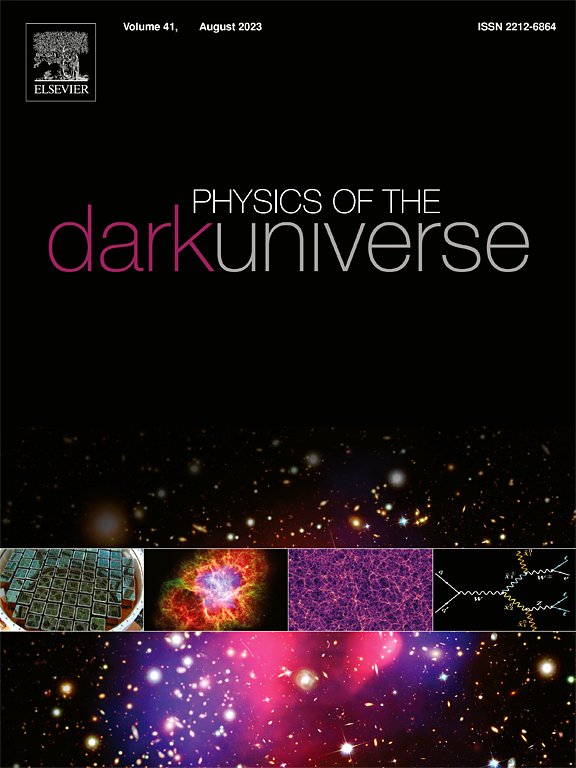慢滚膨胀的三阶修正:普朗克、ACT、SPT和BICEP/Keck的计算和约束
IF 6.4
2区 物理与天体物理
Q1 ASTRONOMY & ASTROPHYSICS
引用次数: 0
摘要
我们研究了通过慢滚近似导出的标量和张量微扰的原始功率谱(PPS)。通过使用格林函数技术求解Mukhanov-Sasaki方程和张量摄动方程,我们将PPS计算扩展到三阶修正,与文献中先前提出的积分解的独立方法相比,提供了慢滚参数方面的全面展开。本文利用微扰方程的数值解,研究了从一阶修正到三阶修正的解析预测的准确性。我们从普朗克、ACT、SPT和BICEP/Keck数据中推导出哈勃流函数ϵi的约束。我们发现在95% CL下,由BICEP/Keck数据主导的上界ϵ1 > 0.002,并且对所有不同的数据集组合都具有鲁棒性。我们将普朗克数据与重子声振荡、红移空间变形和超新星一阶数据相结合,得到了在68%置信水平下ϵ2≃0.031±0.004的约束。ϵ2上的不确定性变得更大,包括二阶和三阶修正,分别允许不消失的运行和运行的运行,导致ϵ2在68% CL处≃0.034±0.007。在二阶和三阶慢滚扩展的光谱中,我们发现在95% CL处ϵ3≃0.1±0.4。ϵ4始终不受约束。普朗克和SPT数据的结合,彼此兼容,导致对ϵ2和ϵ3的约束稍微严格一些。相反,将普朗克数据与ACT测量相结合导致ϵ2和ϵ3的平均值和最大似然值发生了变化,因为与普朗克的发现相比,ACT测量指向更高的标量谱指数值。我们讨论了不同数据集组合和不同多极切割的结果。本文章由计算机程序翻译,如有差异,请以英文原文为准。
Third-order corrections to the slow-roll expansion: Calculation and constraints with Planck, ACT, SPT, and BICEP/Keck
We investigate the primordial power spectra (PPS) of scalar and tensor perturbations, derived through the slow-roll approximation. By solving the Mukhanov-Sasaki equation and the tensor perturbation equation with Green’s function techniques, we extend the PPS calculations to third-order corrections, providing a comprehensive expansion in terms of slow-roll parameters with an independent approach to the solution of the integrals compared to the one previously presented in the literature. We investigate the accuracy of the analytic predictions starting from first-order corrections up to third-order ones with the numerical solutions of the perturbation equations for a selection of single-field slow-roll inflationary models. We derive the constraints on the Hubble flow functions from Planck, ACT, SPT, and BICEP/Keck data. We find an upper bound at 95% CL dominated by BICEP/Keck data and robust to all the different combination of datasets. We derive the constraint at 68% confidence level (CL) from the combination of Planck data and late-time probes such as baryon acoustic oscillations, redshift space distortions, and supernovae data at first order in the slow-roll expansion. The uncertainty on gets larger including second- and third-order corrections, allowing for a non-vanishing running and running of the running respectively, leading to at 68% CL. We find at 95% CL both at second and at third order in the slow-roll expansion of the spectra. remains always unconstrained. The combination of Planck and SPT data, compatible among each others, leads to slightly tighter constraints on and . On the contrary, the combination of Planck data with ACT measurements, which point to higher values of the scalar spectral index compared to Planck findings, leads to shifts in the means and maximum likelihood values for and . We discuss the results obtained for different dataset combinations and different multipole cuts.
求助全文
通过发布文献求助,成功后即可免费获取论文全文。
去求助
来源期刊

Physics of the Dark Universe
ASTRONOMY & ASTROPHYSICS-
CiteScore
9.60
自引率
7.30%
发文量
118
审稿时长
61 days
期刊介绍:
Physics of the Dark Universe is an innovative online-only journal that offers rapid publication of peer-reviewed, original research articles considered of high scientific impact.
The journal is focused on the understanding of Dark Matter, Dark Energy, Early Universe, gravitational waves and neutrinos, covering all theoretical, experimental and phenomenological aspects.
 求助内容:
求助内容: 应助结果提醒方式:
应助结果提醒方式:


